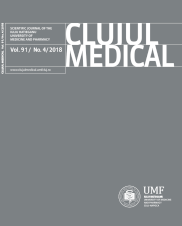PULSE PRESSURE IS MORE RELEVANT THAN SYSTOLIC AND DIASTOLIC BLOOD PRESSURE IN PATIENTS WITH TYPE 2 DIABETES AND CARDIOVASCULAR DISEASE
DOI:
https://doi.org/10.15386/cjmed-972Keywords:
diabetes mellitus, cardiovascular disease, ambulatory blood pressure monitoring, pulse pressureAbstract
Background and aims. The parameters evaluated during 24-hour ambulatory blood pressure monitoring were reported to be predictors of cardiovascular events. We aimed to investigate mean blood pressure, blood pressure variability and pulse pressure during 24-hour ambulatory blood pressure monitoring in type 2 diabetes patients and to establish their relationship with the presence of atherosclerotic cardiovascular disease (CVD).
Methods. The observational study included type 2 diabetes patients randomly selected and distributed in 2 study groups depending on the presence of atherosclerotic cardiovascular disease: CVD(-), n=90, and CVD(+), n=87. Daytime, nighttime and 24-hour systolic and diastolic blood pressure were monitored and mean blood pressure, blood pressure variability and pulse pressure were calculated.
Results. The study groups were comparable as age, gender ratio, smoking status, body mass index and abdominal circumference. Diabetes and hypertension duration were significantly higher in the CVD(+) group. Mean systolic and diastolic blood pressure, blood variability, dipper prevalence did not differ between study groups. Pulse pressure was significantly higher in the CVD(+) group compared to CVD(-) group (daytime pulse pressure 56.2±13.1 vs. 50.6±11.3 mmHg, p=0.003; nighttime pulse pressure 56.5±14.2 vs. 50.7±12.4 mmHg, p=0.005; 24-hour pulse pressure 54.7±13.6 vs. 49.0±12.0 mmHg, p=0.003).
Conclusions. Ambulatory pulse pressure was significantly higher in patients with type 2 diabetes and atherosclerotic cardiovascular disease compared to those without cardiovascular disease, although mean systolic and diastolic blood pressure and blood pressure variability were similar.
Downloads
Additional Files
Published
How to Cite
Issue
Section
License
The authors are required to transfer the copyright of the published paper to the journal. This is done by agreeing to sign the Copyright Assignment Form. Whenever the case, authors are also required to send permissions to reproduce material (such as illustrations) from the copyright holder.

The papers published in the journal are licensed under a Creative Commons Attribution-NonCommercial-NoDerivatives 4.0 International License.

